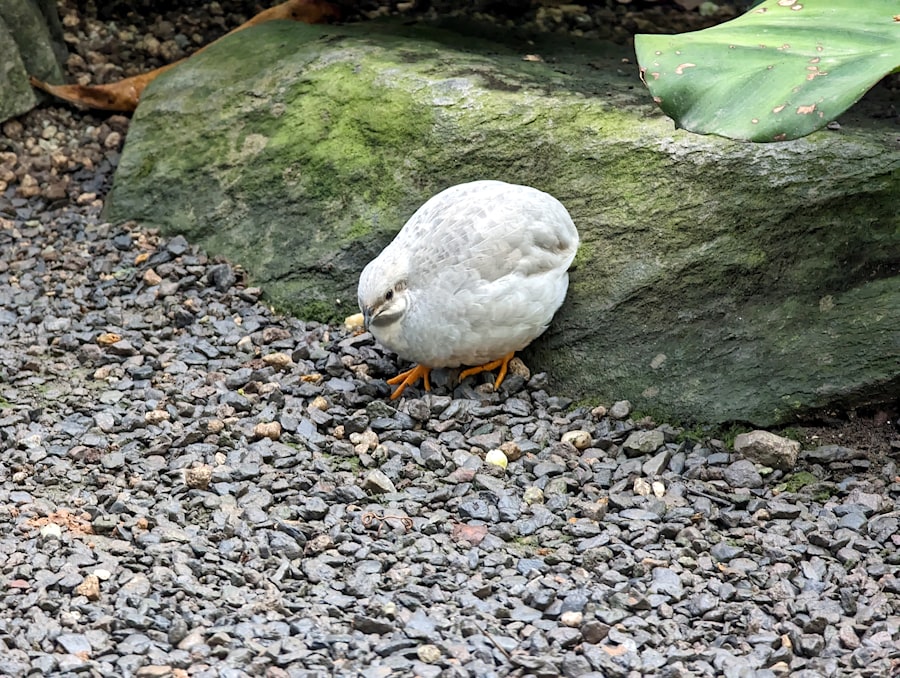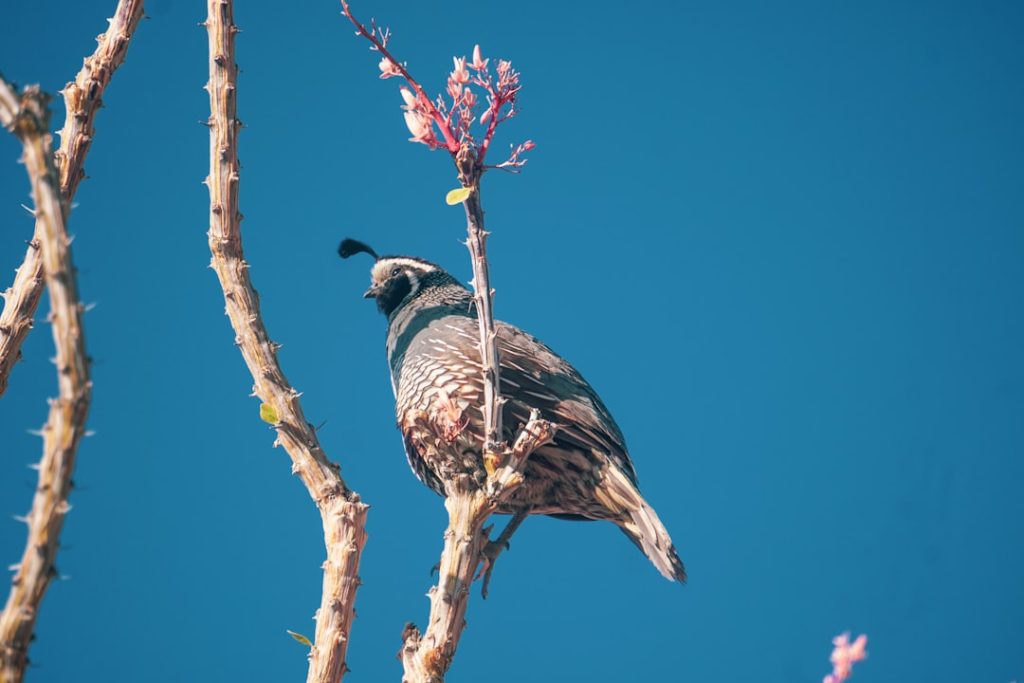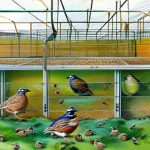Coturnix quail, also known as Japanese quail, are small game birds that are popular for their meat and eggs. They are native to East Asia and have been domesticated for thousands of years. Coturnix quail are known for their fast growth rate, high egg production, and adaptability to various environments, making them a popular choice for small-scale poultry farmers and homesteaders. There are several different breeds of Coturnix quail, each with its own unique characteristics and traits. In this article, we will explore the various breeds of Coturnix quail, their physical traits, breeding and rearing methods, care and housing requirements, as well as their uses and benefits.
Table of Contents
Key Takeaways
- Coturnix quail are small, hardy birds that are popular for their meat and eggs.
- They come in a variety of colors and patterns, with distinct physical traits such as a plump body and speckled feathers.
- Popular breeds of Coturnix quail include the Pharaoh, Texas A&M, and Italian.
- Breeding and rearing Coturnix quail requires attention to temperature, diet, and space for nesting and hatching.
- Care and housing requirements for Coturnix quail include providing a balanced diet, clean water, and a safe, spacious enclosure.
Characteristics and Physical Traits of Coturnix Quail
Coturnix quail are small birds, typically measuring around 7-8 inches in length and weighing between 4-6 ounces. They have a plump body, short legs, and a rounded head with a short beak. Their plumage can vary in color, with common varieties including brown, white, and speckled patterns. Coturnix quail are known for their rapid growth, reaching maturity in just 6-8 weeks. They are also prolific layers, with hens laying up to 300 eggs per year. In terms of temperament, Coturnix quail are generally docile and easy to handle, making them a great choice for beginners or those with limited space. They are also relatively quiet birds, making them suitable for urban or suburban settings.
Coturnix quail are also known for their high feed conversion ratio, meaning they efficiently convert feed into meat and eggs. This makes them a cost-effective option for those looking to raise poultry for meat or eggs. Additionally, Coturnix quail are hardy birds that can adapt to a wide range of climates, making them suitable for various regions around the world. Overall, the physical traits and characteristics of Coturnix quail make them an attractive option for small-scale poultry production.
Popular Breeds of Coturnix Quail
There are several popular breeds of Coturnix quail, each with its own unique characteristics and traits. The most common breeds include the Pharaoh, Italian, Tuxedo, and Texas A&M. The Pharaoh quail is one of the most widely recognized breeds, known for its brown plumage with speckled markings. The Italian quail is similar in appearance to the Pharaoh, but with a lighter coloration and more pronounced speckling. The Tuxedo quail is named for its distinctive black and white plumage, while the Texas A&M quail is bred specifically for its high egg production and fast growth rate.
Each breed of Coturnix quail has its own unique advantages and characteristics, making it important for prospective quail farmers to research and choose the breed that best suits their needs and goals. Whether it’s for meat production, egg-laying capacity, or aesthetic appeal, there is a Coturnix quail breed to fit every farmer’s preferences.
Breeding and Rearing Coturnix Quail
Breeding and rearing Coturnix quail is relatively straightforward, making them an ideal choice for beginners or those with limited experience in poultry farming. Quail can be bred in cages or aviaries, with one male typically being kept with several females to ensure successful mating. The eggs are then collected and placed in an incubator or under a broody hen for hatching. Once hatched, the chicks require a warm and secure brooder environment to thrive.
Coturnix quail chicks grow rapidly and can be raised on a diet of commercial game bird starter feed. They reach maturity in just 6-8 weeks, at which point they can be processed for meat or begin laying eggs. Breeding and rearing Coturnix quail is a rewarding experience that can provide a sustainable source of meat and eggs for the small-scale farmer.
Care and Housing Requirements for Coturnix Quail
Coturnix quail have relatively simple care and housing requirements, making them an attractive option for those with limited space or resources. Quail can be housed in cages or aviaries, with each bird requiring only a small amount of space. The housing should provide protection from predators and the elements, as well as adequate ventilation to prevent respiratory issues.
Quail also require a balanced diet of commercial game bird feed, supplemented with fresh greens and occasional treats such as mealworms or kitchen scraps. Clean water should be provided at all times, either through waterers or shallow dishes to prevent drowning.
Overall, the care and housing requirements for Coturnix quail are minimal, making them an ideal choice for those looking to raise poultry in a small-scale or backyard setting.
Uses and Benefits of Coturnix Quail Breeds

Coturnix quail have a wide range of uses and benefits, making them a valuable addition to any small-scale farm or homestead. Their meat is lean and flavorful, making it a popular choice for gourmet dishes and specialty markets. Quail eggs are also highly sought after for their rich flavor and nutritional benefits.
In addition to their meat and eggs, Coturnix quail are also used for their feathers, which can be used in crafts and fly tying for fishing. Their manure is a valuable source of fertilizer for gardens and crops, making them a sustainable addition to any farming operation.
Overall, the uses and benefits of Coturnix quail breeds make them a versatile and valuable asset for small-scale farmers and homesteaders.
Tips for Choosing and Caring for Coturnix Quail Breeds
When choosing Coturnix quail breeds, it’s important to consider your specific goals and needs. Whether it’s for meat production, egg-laying capacity, or aesthetic appeal, there is a Coturnix quail breed to fit every farmer’s preferences.
In terms of caring for Coturnix quail breeds, it’s important to provide them with a clean and secure housing environment, a balanced diet, and regular access to clean water. Additionally, regular health checks and parasite prevention measures should be implemented to ensure the overall well-being of the birds.
Overall, Coturnix quail breeds are a valuable addition to any small-scale farm or homestead, providing a sustainable source of meat, eggs, feathers, and fertilizer. With proper care and management, these small game birds can provide a wide range of benefits for the conscientious farmer or homesteader.
If you’re interested in learning more about raising quail, you might also want to check out Poultry Wizard’s article on “Can Geese Eat Chicken Feed?” This informative piece delves into the dietary needs of geese and provides valuable insights for poultry enthusiasts. Whether you’re considering raising quail, chickens, or geese, understanding their nutritional requirements is essential for their health and well-being. Check it out here!
FAQs
What are Coturnix quail?
Coturnix quail, also known as Japanese quail, are a species of Old World quail that are commonly raised for their meat and eggs. They are smaller in size compared to other quail species and are known for their fast growth and high egg production.
What are the different breeds of Coturnix quail?
There are several different breeds of Coturnix quail, including Pharaoh, Italian, Tuxedo, Texas A&M, and Jumbo. Each breed has its own unique characteristics such as plumage color, size, and egg production.
What are the characteristics of Coturnix quail breeds?
Coturnix quail breeds vary in size, color, and egg production. For example, the Pharaoh breed has a brown and white speckled plumage, while the Texas A&M breed is known for its high egg production. Jumbo Coturnix quail are larger in size and are often raised for meat production.
What are the benefits of raising Coturnix quail?
Raising Coturnix quail can be beneficial for their fast growth, high egg production, and relatively low space requirements. They are also known for their adaptability to various climates and are relatively easy to care for.
What are the common uses of Coturnix quail?
Coturnix quail are commonly raised for their meat and eggs. Their meat is considered a delicacy in many cultures, and their eggs are prized for their small size and rich flavor. Additionally, some people raise Coturnix quail as pets or for their ornamental plumage.
Meet Walter, the feathered-friend fanatic of Florida! Nestled in the sunshine state, Walter struts through life with his feathered companions, clucking his way to happiness. With a coop that’s fancier than a five-star hotel, he’s the Don Juan of the chicken world. When he’s not teaching his hens to do the cha-cha, you’ll find him in a heated debate with his prized rooster, Sir Clucks-a-Lot. Walter’s poultry passion is no yolk; he’s the sunny-side-up guy you never knew you needed in your flock of friends!







